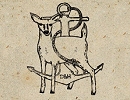Contact Seller
Doe And Hope
Tel07729 213013Please quote Antiques Atlas.


 Victorian Marble Bust of a Young Woman, c.1850–187
Victorian Marble Bust of a Young Woman, c.1850–187
 Art Nouveau Bust by Goldscheider c.1900
Art Nouveau Bust by Goldscheider c.1900
 J.W Rollins Marble Bust of a Gentleman Dated 1897
J.W Rollins Marble Bust of a Gentleman Dated 1897
 19th century alabaster bust of Poesie
19th century alabaster bust of Poesie
 Mid Victorian Marble bust of a young girl
Mid Victorian Marble bust of a young girl
 A Large 19th Century Alabaster Bust.
A Large 19th Century Alabaster Bust.
 Marble sculpture depicting Madame Recamier. France
Marble sculpture depicting Madame Recamier. France
 A Very Large French Bronze Bust Of Jesus Christ
A Very Large French Bronze Bust Of Jesus Christ
 Artist’s Model Bust of a Very Young Smiling Boy
Artist’s Model Bust of a Very Young Smiling Boy
 Large fine quality marble bust of James Loch MP
Large fine quality marble bust of James Loch MP
 A Pair Of 19th Century Marble Busts.
A Pair Of 19th Century Marble Busts.
 Terracotta Bust of Madame de Récamier c.1900
Terracotta Bust of Madame de Récamier c.1900
Non UK callers :
+44 7729 213013
Classical Plaster Portrait Bust of a Roman c.1900


The large plaster bust of a Roman youth or young gentleman in the classical Julio-Claudian (mid-late 1st century AD) style survives from the late nineteenth century.
The condition of the bust is pretty good throughout. There are no noticeable chips or cracks and no areas of loss. There is an all-over weathering to the piece being consistent with age, the finish worn in the extremities. This bust is a Victorian cast, most likely of an ancient example, but we do not know who the sitter is.
Wealthy Romans were having their own or their children's portraits carried out by the late 1stC ad. and though Roman private portrait sculpture was most closely associated with funerary contexts. In the Republic, public sculpture included honorific portrait statues of political officials or military commanders erected by the order of their peers in the Senate. These statues were typically erected to celebrate a noted military achievement, usually in connection with an official triumph, or to commemorate some worthy political achievement, such as the drafting of a treaty. Roman portraiture is also unique in comparison to that of other ancient cultures because of the complex and ever-evolving stylistic treatment of human features and character.
The Empire never seemed so tangibly close.
SellerDoe And Hope
View all stock from
Doe And Hope

 Private dealer, By appointment only
Private dealer, By appointment only
The Onion Barn, Shoe Cottage,
15 High Street, Blunham,
Bedfordshire, MK44 3NL.
MK44 3NL
Tel : 07729 213013
Non UK callers : +44 7729 213013
Get directions to Doe And Hope
The condition of the bust is pretty good throughout. There are no noticeable chips or cracks and no areas of loss. There is an all-over weathering to the piece being consistent with age, the finish worn in the extremities. This bust is a Victorian cast, most likely of an ancient example, but we do not know who the sitter is.
Wealthy Romans were having their own or their children's portraits carried out by the late 1stC ad. and though Roman private portrait sculpture was most closely associated with funerary contexts. In the Republic, public sculpture included honorific portrait statues of political officials or military commanders erected by the order of their peers in the Senate. These statues were typically erected to celebrate a noted military achievement, usually in connection with an official triumph, or to commemorate some worthy political achievement, such as the drafting of a treaty. Roman portraiture is also unique in comparison to that of other ancient cultures because of the complex and ever-evolving stylistic treatment of human features and character.
The Empire never seemed so tangibly close.
Price The price has been listed in British Pounds.
Conversion rates as of 22/DEC/2025. Euro & Dollar prices will vary and should only be used as a guide.
Always confirm final price with dealer. Phone or visit the website to buy, Free UK shipping.
Category Busts and Figures
Date c.1900
1900s Antiques Material Plaster
Origin Roman
Item code as155a1386
Status Sold
£750.00 
$1009.05 
€857.78 

$

€

Conversion rates as of 22/DEC/2025. Euro & Dollar prices will vary and should only be used as a guide.
Always confirm final price with dealer. Phone or visit the website to buy, Free UK shipping.
View all stock from
Doe And Hope

 Private dealer, By appointment only
Private dealer, By appointment onlyThe Onion Barn, Shoe Cottage,
15 High Street, Blunham,
Bedfordshire, MK44 3NL.
MK44 3NL
Tel : 07729 213013
Non UK callers : +44 7729 213013
Get directions to Doe And Hope
You may also be interested in
 Victorian Marble Bust of a Young Woman, c.1850–187
Victorian Marble Bust of a Young Woman, c.1850–187
 Art Nouveau Bust by Goldscheider c.1900
Art Nouveau Bust by Goldscheider c.1900
 J.W Rollins Marble Bust of a Gentleman Dated 1897
J.W Rollins Marble Bust of a Gentleman Dated 1897
 19th century alabaster bust of Poesie
19th century alabaster bust of Poesie
 Mid Victorian Marble bust of a young girl
Mid Victorian Marble bust of a young girl
 A Large 19th Century Alabaster Bust.
A Large 19th Century Alabaster Bust.
 Marble sculpture depicting Madame Recamier. France
Marble sculpture depicting Madame Recamier. France
 A Very Large French Bronze Bust Of Jesus Christ
A Very Large French Bronze Bust Of Jesus Christ
 Artist’s Model Bust of a Very Young Smiling Boy
Artist’s Model Bust of a Very Young Smiling Boy
 Large fine quality marble bust of James Loch MP
Large fine quality marble bust of James Loch MP
 A Pair Of 19th Century Marble Busts.
A Pair Of 19th Century Marble Busts.
 Terracotta Bust of Madame de Récamier c.1900
Terracotta Bust of Madame de Récamier c.1900








